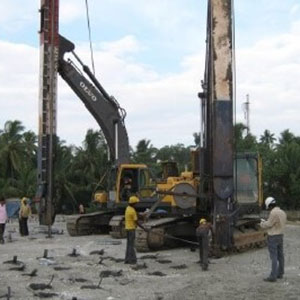The following Ground Improvement Techniques under precompression are generally adopted in different construction projects as per the requirement depending on the existing soil condition.
Soil Improvement Methods under Precompression:
Preloading with/without Drain:
In this Ground Improvement Techniques, loading is applied sufficiently before construction to complete the compression of soft soils. It helps to reduce water content and void ratio and increase strength.
The most suitable soil conditions/types for preloading with or without vertical drains are consolidated soft clays, silts, organic deposits, and completed sanitary landfills. Materials required for the above types of ground improvement are earth fill or other material for loading the site and sand or gravel for drainage blanket.
Equipment required:
In this Ground Improvement Techniques, following equipment like earthmoving equipment, roller, large water tanks, and sometimes vacuum drainage systems are used, and for settlement markers, piezometers are normally used.
Advantages:
- An easy and well-developed theory
Limitations:
- Requires long time (vertical drains can be used to reduce consolidation time)
Also, Read: Top 7 Ground Improvement Techniques in Civil Engineering
Surcharge fills:
The fill above that is required permanently is applied to achieve a given amount of settlement in a shorter period, and excess fill is then removed. The relative cost of this Ground Improvement Techniques is moderate, and it helps to reduce water content, void ratio and compressibility and increase the strength of treated materials.
In the case of surcharge fills, the most suitable soil conditions/types are consolidated soft clays, silts, organic deposits, completed sanitary landfills etc. Material and equipment requirements are the same as described above for preloading with/without vertical drains.
Advantages:
- Faster than preloading without surcharge
- Can use vertical drains to reduce consolidation time
- Theory well developed
Limitations:
- Extra material handling

Also, Read: Soil Reinforcement Methods – Advantages and limitations
Electro osmosis:
In this method, DC current causes water to flow from the anode towards the cathode, where it is being removed. The procedure is suitable for consolidated silts and silty clay. Reducing water content and compressibility provides strength and electrochemical hardening to the treated materials. The relative cost of this method is high.
Materials required for the above types of ground improvement are DC power supply and wiring metering systems.
Advantages:
- No fill or loading is required
- Can be used in confined areas
- Relatively fast procedure
Limitations:
- Non-uniform properties between electrodes
- Not good in highly conductive soils
What is Vertical Drain?
Vertical drains help to improve the strength of soft cohesive soil by removing water voids and accelerating settlement. Bearing failures may occur without vertical drains, and clay soils may develop settlements over many years. Preloading combined with vertical drains has become an easy and economical choice of ground improvement technique.
Advantages of Vertical Drains:
- It helps to accelerate primary consolidation for Soft Soil.
- Develop in-situ shear strength of soft soil.
- Applicable in case of non-replaceable significant depth of Soft Soil.
- Depending upon the site condition, vertical drain efficiency may maximise up to 80%.
Types of Vertical Drains:
There are four types of vertical drains used for ground improvement techniques.
Soil Improvement using Vertical Sand Drains:
Sand drains simply consisted of boreholes filled with sand. The holes may have been formed by boring, drilling or augering and would have 150 to 500mm diameters with spacing 1.5m to 6.0m apart. Large diameter sand drains allow consolidation of surrounding soft soil and also provide vertical compressive soil reinforcement that could transfer surface loads to strong bearing stratum at depths.
- Diameter: The sand drains of 150 mm to 500 mm diameter are used for ground improvement.
- Spacing: Spacing of vertical sand drains maintains between 1.50 m to 6.00 m.
- Installation: Closed Mandrel or open mandrel method is adopted.
Soil Improvement using Vertical Sand Wicks:
Small diameter sand drain prepacked in filter stocking (woven jute canvas) are installed in soft soils to accelerate the consolidation by providing additional drainage paths for pore water to escape.
- Advantages: Economic than large diameter vertical sand drains
- Installation: Simplest Method – Hand auger (for limited depth)
Also, Read: Major Role of Ground Improvement in The Structure Foundations
Soil Improvement using Vertical Cardboard Drains:
Swedish Geotechnical Institute by Kjellman developed the first strip drain, and it was made of cardboard with internal ducts. Cardboard drains have dimensions 100mm wide and 3mm thick with internal drainage passages used for soft soil improvement.
- Dimension: 100 mm x 3 mm
- Installation: With the help of a mandrel, which is removed after placing up to the desired depth.
- In this method, a little soil disturbance may occur, but long life and durable system.
Ground Improvement Techniques using Geosynthetic Drains:
Most geosynthetic drains are strip-shaped or circular plastic drainage pipes that serve as vertical drains wrapped in a geotextile. It is a fast and sophisticated soil improvement method, an updated version of cardboard drain known as Prefabricated vertical band drain (PVBD).
- Dimension: 100 mm x 2.5 mm to 7.0 mm.
- Installation: Using the displacement method by the mandrel.
- Range: Large depth installation – may be up to 25.0m to 30.00m.
- Spacing and depth: Square or Triangular pattern – 1.00m to 4.00m.

Also, Read: Vibroflotation, Blasting & Dynamic Compaction – Ground Improvement
Theoretical Considerations:
- Dimension and spacing of drain required degree of consolidation in a particular time (i.e. Waiting Period) for a known type of drain and analysis based on the three-dimensional consolidation process.
- Consideration of the smearing effect during analysis is essential.
- Required Drainage parameters: Coefficient of consolidation in both horizontal and vertical direction of soft foundation soil in addition to the vertical drain characteristics(discharge capacity) should be considered.
Reference: IS: 13094





